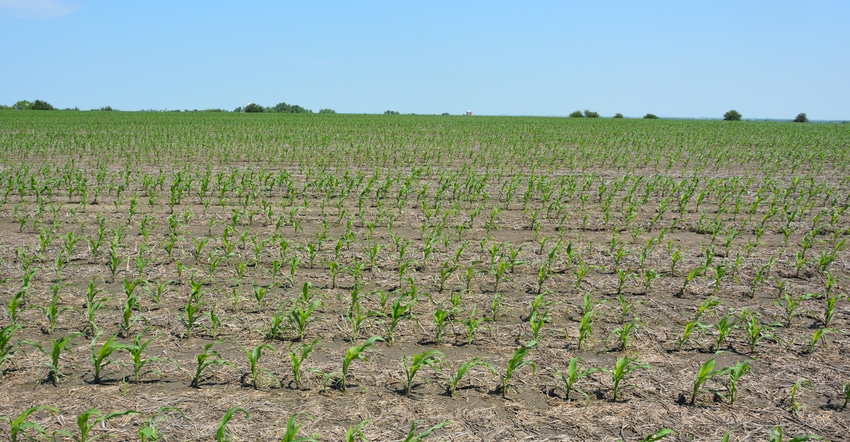
There’s no doubt that part of the Kansas wheat crop sustained some significant frost damage. But a cool, wet start to May was just what the doctor ordered to get secondary and tertiary tillers off and growing, even though a stretch of rainy days with daytime highs in the mid-40s wasn’t exactly music to the ears of farmers anxious to get summer crops planted.
Eric Hanson, regional agronomist with Winfield United, says a lot of farmers did get corn planted and up during the warm, sunny days at the end of April and were happy to see much needed rain.
“We’ve got our research plots planted and we’re happy to see a lot o crops going into the ground. I’m optimistic for a good growing season,” Hanson says.
He says COVID-19 travel restrictions have kept him from actually scouting as many fields and talking face to face with the farmers at the pace he’d would normally be at this time of year, but he knows that there has been a lot of fungicide sprayed in central and eastern Kansas as crop scouts warn of the early appearance of leaf and stripe rust.
“In this kind of year, the farmers who do have wheat that survived the freeze want to do everything they can to protect against yield loss,” he says. “Fungicide is an input that pays for itself.”
Yield loss protection
For farmers that did have severe losses from the successive freezes in mid-April, it’s not too late to give up on wheat and plant corn, but the window is rapidly closing.
“We’ve seen more hybrids that can be planted well into May without as much risk we used to have,” Hanson says. “With good moisture you could put corn on that lost wheat. Where moisture is not so good, maybe go in with sorghum.
First and foremost, he says farmers planting into lost wheat need to stay aware of their herbicide rotation restrictions when considering a summer crop.
“If you are going with a nitrogen-loving crop like corn, you need to be aware that a lot of the nitrogen you used to topdress wheat is going to be tied up in the residue for a period of time before it is available to the new crop,” he says. “You will need to stay on top of early-season nitrogen.”
As the corn gets up and growing, it’s time to think about a postemergence herbicide application to make sure you have weed control through the season.
“As tank mixes get more complicated, using proper mixing order is important to reduce compatibility issues and plugged nozzles as well as herbicide efficacy,” he says. “Matching the right adjuvants to the herbicide program and weather conditions also help improve consistency and performance.
“It’s also good to pull some tissue samples on the corn to make sure there are no fertility issues. Getting it off to a good, strong start enables it to handle the stress that comes later in the season. With our clients, we use our Field Forecasting Tool that uses short and long term weather and crop models to predict when the crop will be deficient in nitrogen, potassium or moisture and can provide a recommendation on timing and rates of optimum ROI of inputs like side-dress nitrogen.”
Moving toward the end of May, the focus will be more on soybeans and cotton.
“I recommend seed treatments to get good stands established and herbicide management is absolutely essential,” he says. “If you are looking to cut cost, herbicide programs are not the place to do it. We have more options for postemergence herbicides now, but that preplant burndown with something that has good residual action is still really important. You have to stay ahead of those resistant weeds.”
He says tissue sampling just as beans begin to bloom is a good guide to what micronutrient applications might be a good idea.
“Make sure to utilize all the tools to help you make decisions,” he says. “The field forecasting tool, crop modeling, awareness of genetics all work together to help you take a systems approach to managing the crop. When ties are tough it is really tempting to pick apart the program and try to pick the one or two things that you do. But it is actually the combination that gives you the best bang for your buck.”
Winfield United has a limited release service offering called the Advanced Acre Rx that provides a systems approach to inputs that is backed by Answer Plot research. The package of inputs comes with a warranty that if a producer using it fails to hit a designated level of production, he gets a refund on part of the cost of the program.
He says research has been underway for nearly a decade to test several different corn hybrids including the Winfield United brand, Croplan, alongside partnered brands of NK, Dekalb and Mycogen to drill down on which genetics have the best response to nitrogen, fungicide and crop rotation.
“We’re look at 6 million data points every year,” Hanson says. “Hybrids turn over so quickly. We used to have a new hybrid that we put on the farm for a couple of years and it would be the ‘go-to’ hybrid for five or six years.
“Now the lifetime of a corn hybrid is so short that we went to this system so growers would have information on what population to plant, and how much nitrogen and fungicide will get the most out of that hybrid in the first year. It’s all about helping farmers make better decisions.”
About the Author(s)
You May Also Like






